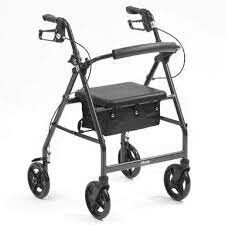A rollator is a mobility aid for people that require some more support with their mobility. It is often associated with the elderly, however there are many different variations of the rollator and they are used by a variety of people, including children. The rollator redistributes body weight from the legs of its users to the arms through the walking aid and therefore reduces pain, fatigue and improves safety and confidence. They are used for individuals with reduced strength, balance and confidence due to frailty, injury, operation or neurological conditions.
The modern day rollator was invented in 1978 by Aina Wifalk, a Polio suffer. It consists of a frame with three or four wheels, handlebars, brakes and a built-in seat, which allows the user to stop and rest when needed.
Another design of the rollator is a Zimmer frame which is used indoors. It is a lightweight frame that comes in various sizes and surrounds the users’ front and sides and their hands provide additional support by holding on to the top of the sides.
The rollator, in some form or another, has been around for a very long time. In a famous painting by the artist Hieronymus Bosch (painted around 1501), there is an illustration of a man walking, enclosed within a frame with four wheels. Walking frames themselves go back even further, with the oldest known representation of one being a 1st or 2nd century Egyptian terracotta figurine, currently on display at the British Museum in London.
Description provided by Claire Thomas of the United Kingdom

